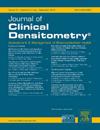Opportunistic Screening for Low Bone Mineral Density in Routine Computed Tomography Scans: A Brazilian Validation Study
IF 1.6
4区 医学
Q4 ENDOCRINOLOGY & METABOLISM
引用次数: 0
Abstract
Introduction/background: Osteoporotic fractures are a major health concern worldwide due to high mortality rates, deterioration in quality of life, and elevated healthcare costs related to hospital treatment. However, most patients who sustain an osteoporotic fracture have never been formally screened for osteoporosis. Opportunistic screening of osteoporosis through conventional computed tomography (CT) scans performed for unrelated reasons could help identify patients with low bone mass. There are currently no studies validating the opportunistic screening of low bone mass through CT in South America. The aim of our study is to assess whether conventional CT scans could be used for the opportunistic screening of osteopenia and osteoporosis in Brazilian patients.
Methodology: Patients who underwent unenhanced CT and dual-energy X-ray absorptiometry (DXA) scans within a six-month interval were assessed retrospectively. Mean CT attenuation was measured in the first lumbar vertebra (L1) in axial, coronal, and sagittal planes and compared to their respective DXA T-scores; vertebral fractures were assessed in the sagittal plane. Potential thresholds suggestive of low bone mass density (BMD) were established using receiver operating characteristics analysis.
Results: 491 patients were included (93.2 % female; mean age of 64.1 ± 9.8 years; mean interval of 63.5 days between scans). Mean L1 CT attenuation was significantly lower in osteopenic and osteoporotic patients in all CT planes (p < 0.001). Positive linear correlations were found between DXA T-scores and the average L1 attenuations in all CT planes (p < 0.001). An average L1 attenuation equal or below 100 Hounsfield Units (HU) in the sagittal plane identified low BMD (osteopenia or osteoporosis) with a specificity of 96.3 % and a positive predictive value of 96 %. In contrast, an average L1 attenuation above 180 HU demonstrated a sensitivity of 97.6 % and a negative predictive value of 94.9 % for detecting osteoporosis. Patients with L1 sagittal attenuation at or below 100 HU exhibited a significantly higher prevalence of vertebral fractures (prevalence ratio: 8.67; p < 0.001). An online calculator based on the results of this study is freely available at www.osteotc.com.br.
Conclusions: Routine CT scans can identify probable low bone density (osteopenia or osteoporosis) in Brazilian patients without additional costs or radiation exposure. Opportunistic CT screening does not substitute formal bone mineral density assessment; instead, it assists in identifying patients who may benefit from it.
常规计算机断层扫描中的低骨密度机会性筛查:巴西验证研究
导言/背景:骨质疏松性骨折是全球关注的主要健康问题,因为其死亡率高、生活质量下降以及与医院治疗相关的医疗费用增加。然而,大多数骨质疏松性骨折患者从未接受过正规的骨质疏松症筛查。通过与此无关的常规计算机断层扫描(CT)对骨质疏松症进行机会性筛查,有助于发现低骨量患者。目前,南美洲还没有研究验证通过 CT 对低骨量患者进行机会性筛查。我们的研究旨在评估常规 CT 扫描是否可用于巴西患者骨质疏松症和骨质疏松症的机会性筛查:我们对在六个月内接受过非增强 CT 和双能 X 射线吸收测量(DXA)扫描的患者进行了回顾性评估。在轴向、冠状面和矢状面测量第一腰椎(L1)的平均CT衰减,并与各自的DXA T-scores进行比较;在矢状面评估椎体骨折。通过接收器操作特性分析确定了提示低骨质密度(BMD)的潜在阈值:共纳入 491 名患者(93.2% 为女性;平均年龄为 64.1 ± 9.8 岁;平均扫描间隔为 63.5 天)。在所有 CT 平面上,骨质疏松和骨质疏松症患者的 L1 CT 平均衰减量都明显较低(p 结论:常规 CT 扫描可识别可能的骨质疏松症:常规 CT 扫描可发现巴西患者可能存在的低骨密度(骨质疏松症或骨质疏松症),且无需额外费用或辐射暴露。机会性 CT 筛查并不能取代正规的骨矿密度评估,相反,它有助于识别可能从中受益的患者。
本文章由计算机程序翻译,如有差异,请以英文原文为准。
求助全文
约1分钟内获得全文
求助全文
来源期刊

Journal of Clinical Densitometry
医学-内分泌学与代谢
CiteScore
4.90
自引率
8.00%
发文量
92
审稿时长
90 days
期刊介绍:
The Journal is committed to serving ISCD''s mission - the education of heterogenous physician specialties and technologists who are involved in the clinical assessment of skeletal health. The focus of JCD is bone mass measurement, including epidemiology of bone mass, how drugs and diseases alter bone mass, new techniques and quality assurance in bone mass imaging technologies, and bone mass health/economics.
Combining high quality research and review articles with sound, practice-oriented advice, JCD meets the diverse diagnostic and management needs of radiologists, endocrinologists, nephrologists, rheumatologists, gynecologists, family physicians, internists, and technologists whose patients require diagnostic clinical densitometry for therapeutic management.
 求助内容:
求助内容: 应助结果提醒方式:
应助结果提醒方式:


